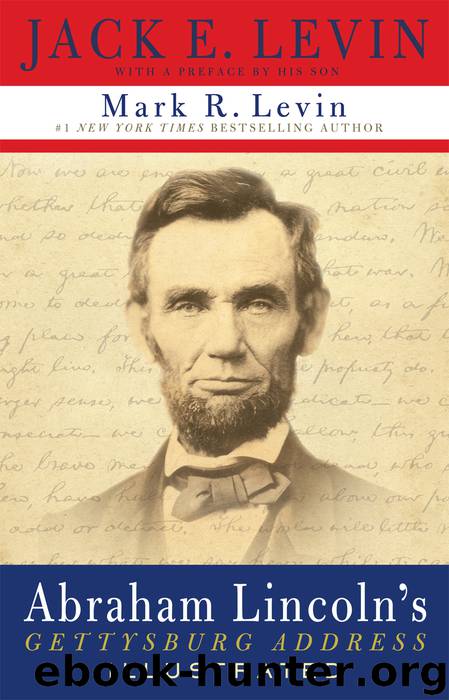Abraham Lincoln's Gettysburg Address Illustrated by Jack E. Levin

Author:Jack E. Levin
Language: eng
Format: epub
Publisher: Threshold Editions
Foreword
On July 1, 1863, the Army of Northern Virginia, commanded by General Robert E. Lee, and the Army of the Potomac, commanded by General George Gordon Meade, met at Gettysburg, then a sleepy Pennsylvania village. Three days of bloody fighting resulted in 28,000 Confederate and 23,000 Union dead and wounded. The fighting was climaxed by the gallant but futile Pickett’s Charge, in which 15,000 Confederate soldiers were repulsed at the moment of breaching the Union lines. The defeated Confederate army withdrew and retreated south. This was the last major attempt to invade the North by a Confederate Army.
Ceremonies were held at the site on November 19, 1863, to dedicate a portion of the battlefield as a national cemetery for the soldiers, both Northern and Southern, who had fallen there. After the bands had played and the dignitaries were introduced, Lincoln listened as Edward Everett, the greatest public speaker of his time, enthralled the crowds with a two-hour oration. When Everett finished, Lincoln, who had been invited to give “a few appropriate remarks,” rose and delivered the Gettysburg Address.
Lincoln thought the speech a failure, but Everett was to write Lincoln the following day, “I should be glad, if I could flatter myself that I came as near to the central idea of the occasion, in two hours, as you did in two minutes.”
As far as we now know, Lincoln actually wrote five copies of the Gettysburg Address in his own hand. Each was slightly different in content. The first copy, the Hay version, he wrote in Washington before going to Gettysburg. The second, the Nicolay version, and the one he supposedly used at the dedication ceremonies, was written while at Gettysburg. The third, the Everett version, he wrote at the request of Edward Everett in February 1864. That same month George Bancroft asked President Lincoln for still another copy, which was to be published in a booklet edited by John P. Kennedy and Colonel Alexander Bliss.
Lincoln sent the fourth, or Bancroft, version to Bancroft on February 29. Having written it on both sides of the paper, the copy was not suitable for reproduction, so Lincoln sent a second copy, permitting Bancroft to keep the first one. This last copy was kept by Colonel Bliss and is known as the Bliss version.
Some historians believe that Lincoln wrote and sent a copy of his address to Judge David Wills, of Gettysburg, but the Wills copy has never been found and therefore cannot be authenticated at this time. The last, the fifth, Bliss or Baltimore version, was used for this book because it is the only one of the five that shows the signature of Lincoln and the date the address was delivered. Also, it is considered to be the version probably most accurate in content to the address as Lincoln actually delivered it at Gettysburg.
In this book, a selected few from the hundreds of remarkable photographs taken by the Civil War photographers Matthew Brady, Alexander Gardner, and their peers are used as graphic complements to the words of the Gettysburg Address.
Download
This site does not store any files on its server. We only index and link to content provided by other sites. Please contact the content providers to delete copyright contents if any and email us, we'll remove relevant links or contents immediately.
| U.K. Prime Ministers | U.S. Presidents |
Waking Up in Heaven: A True Story of Brokenness, Heaven, and Life Again by McVea Crystal & Tresniowski Alex(36999)
Empire of the Sikhs by Patwant Singh(22163)
We're Going to Need More Wine by Gabrielle Union(18065)
Hans Sturm: A Soldier's Odyssey on the Eastern Front by Gordon Williamson(16571)
Leonardo da Vinci by Walter Isaacson(11896)
The Radium Girls by Kate Moore(10902)
Educated by Tara Westover(7055)
Tools of Titans by Timothy Ferriss(6935)
How to Be a Bawse: A Guide to Conquering Life by Lilly Singh(6686)
The Last Black Unicorn by Tiffany Haddish(5065)
Permanent Record by Edward Snowden(4986)
The Rise and Fall of Senator Joe McCarthy by James Cross Giblin(4839)
Promise Me, Dad by Joe Biden(4440)
The Wind in My Hair by Masih Alinejad(4420)
The Crown by Robert Lacey(4099)
A Higher Loyalty: Truth, Lies, and Leadership by James Comey(4024)
The Iron Duke by The Iron Duke(3636)
Joan of Arc by Mary Gordon(3253)
How to be Champion: My Autobiography by Sarah Millican(3180)
